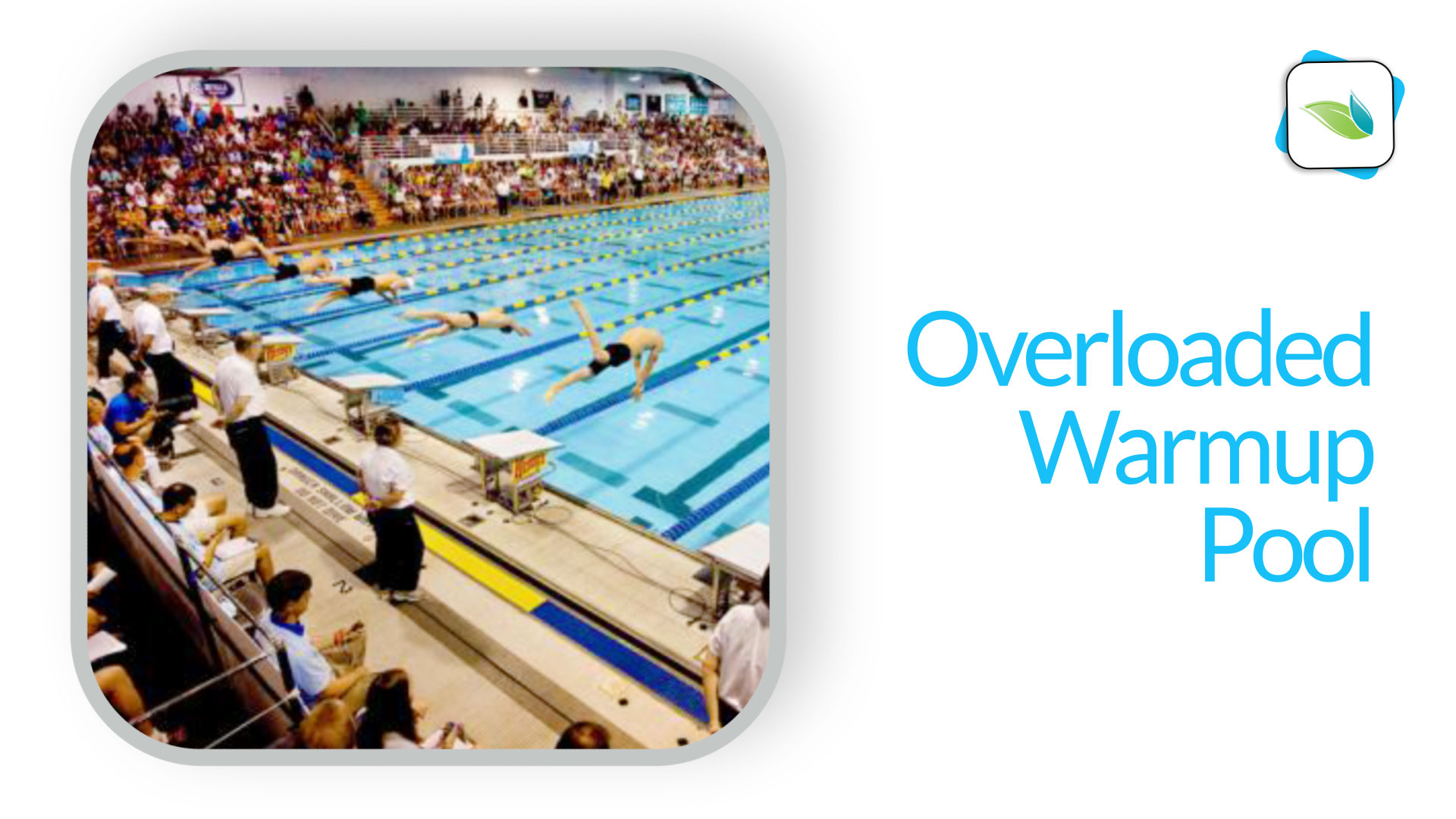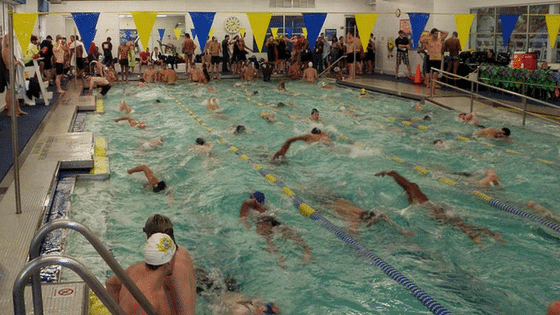An Overloaded Warm-Up Pool

The following is a true story, exactly the way I remember it. Not that I could ever forget my time in that tiny warmup pool...
"It used to be worse?!"
In May, 2011, I moved to Charlotte with every item I owned packed into the bed of my seasoned pickup truck. I arrived a full day before the Charlotte UltraSwim...the first meet of the next chapter in my swimming career. Just thinking about that time makes me smile, and I will never forget it. A few things stood out about that meet. First, I swam decently well for an in-season meet, and second, I experienced the worst pool air quality in my life. I don't say that lightly, because I had an asthma attack during a meet at a different pool in 2009. This pool was far worse; thankfully I was able to run outside into the parking lot and recover as needed. It was so bad that there were often more people outside catching their breath than were in the warmup pool.
The warmup pool was so cloudy it looked like greasy milk, filled with swimmers and their sweat. The air was borderline toxic. My eyes and throat burned. Everyone was miserable, including the coaches.
That small four-lane, 3-foot-deep, 90,000-gallon lap pool was the primary warmup pool for the entire meet. The meet had 850 swimmers, ranging from regional qualifiers to Michael Phelps himself. Rumor has it that the year before, he refused to come back unless the air in the warmup pool was improved.
Enter the Paddock Evacuator. The only problem was it wasn't installed in the right location, so the air was still bad.
Outside in the parking lot, I was talking with my fellow swimmers--total strangers at the time--about trying to warm up in there. One guy told me it was far worse in previous years. "Are you kidding me? It used to be worse in there?!" Evidently so.
Related: Bather Waste and Carbon Management (Pillar 2)
Fast forward a few years...
Swimmers eventually enjoyed decent air quality in the warmup pool because the Evacuator was moved to the right location and fully operational. But the water was far from "quality." The super high chlorine level––which was used to try and address the insane bather load––just made things worse. The water was so cloudy we could hardly see the tile a mere three feet below our faces. By the last day, I could not see my own hands.
Suffice it to say, this pool had a bad reputation for being overcrowded, having disgusting water, and horrible air quality.
The return of the semi-retired
Now let's get to the real story. I had recently moved back to Virginia but returned to Charlotte in May of 2015 to attempt a 2016 Olympic Trial cut in the 50-meter freestyle. When I arrived, I went to warm up in the 50-meter pool. The water was decently clear at the time, though I could not see all the way across the pool. When the finals session was about to begin, we all had to vacate the competition pool so Katie Ledecky could smash another world record. So I moved into the dreaded 4-lane warmup pool.
It was the oddest thing. Not only was the air quality decent in there, but the water was also clear...too clear. Impossibly clear for the situation.
The water felt different too. It felt like the water in the Queens University pool down the road. Orenda treated the Queens University pool, but I never appreciated the difference the enzymes made. They have a big swim team but have never had the 850-swimmer bather load that this little pool did.
I realized I was waist-deep in a liquid science experiment: enzymes vs. a bather load of 850 competitive swimmers in just 90,000 gallons. And you can be sure there was plenty of urea in the pool from swimmers peeing.
Confirmation bias
I finished my warm-up routine and headed out to the sponsor's tent. Lo and behold, Harold and Monica from Orenda were there. This confirmed what I assumed, but I went up to Harold to ask him anyway.
"Are you treating the warmup pool with enzymes?" I asked.
"Why do you ask?" Harold replied, grinning.
"Because it's clear. It feels different. It's better than ever, and I've been swimming in this meet for years."
Our conversation grew. As it turned out, Orenda wanted to treat the competition pool too, but the pool staff wouldn't let it happen. All the better, I thought. It showed such a contrast between the two bodies of water.
I had experienced Orenda enzymes before, at Queens University. But never before in such a dense bather load. This experience proved just how incredible they are for water quality.
The last day of the meet
Typically, water and air quality are horrible by the last day of a meet this size. I personally used the warmup pool at least six times, and I was only swimming in one event. Imagine how many times the other swimmers used the pool.
Thanks to the Evacuator, the air quality remained pretty good throughout the meet...but the water clarity in the 50-meter competition pool was worse than the warm-up pool. It was hard to believe.
Yes, the water become somewhat cloudy by the last day of the meet, but unlike years past, I could still see across the pool underwater. Compared to years past, when I could not see my own hands, it was obvious. That meet was when I became a devout believer in the power of enzyme water treatment.
We don't need complex science to grasp what enzymes do. Enzymes break down bather waste and get it out of the water. Non-living organics are the bulk of chlorine's oxidant demand, yet chlorine is not designed to handle them. Come on, 850 swimmers, multiple times a day? It's insane. Chlorine alone could never handle such a bather load...yet chlorine with the help of CV-600 enzymes did.

